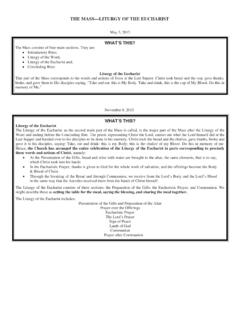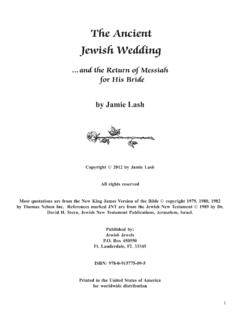Transcription of The General Instruction of the Roman Missal
1 The Roman MissalThe General Instruction of the Roman MissalExcerpts from the English translation of The Roman Missal 2010, International Commission on English in the Liturgy Corporation. All rights edition was prepared by the Liturgy Office of the Bishops Conference and includes particular adaptations for England and Wales 2011 Catholic Bishops Conference of England and Wales. t u r gyOf f i ceEN G L A ND& WA L ESContents iiiContents Introduction 1 Testimony of an Unaltered Faith 1 Uninterrupted tradition 2 Accommodation to New Conditions 3 The Importance and Dignity of the Celebration 1. of the Eucharist 6 The Structure of the Mass, Its Elements and Its Parts2.
2 8I. The General Structure of the Mass 8II. The Different Elements of the Mass 8 Reading and Explaining the Word of God 8 The Prayers and Other Parts Pertaining to the Priest 8 Other Formulae Occurring during the Celebration 9 The Manner of Pronouncing the Different Texts 9 The Importance of Singing 10 Gestures and Bodily Posture 10 Silence 11 III. The Individual Parts of the Mass 11A. The Introductory Rites 11 The Entrance 12 Reverence to the Altar and Greeting of the Assembled People 12 The Penitential Act 12 The Kyrie Eleison 12 The Gloria in Excelsis 13 The Collect 13B. The Liturgy of the Word 13 Silence 14 The Biblical Readings 14 The Responsorial Psalm 14 The Acclamation before the Gospel 15 The Homily 15 The Profession of Faith 16 The Universal Prayer 16C.
3 The Liturgy of the Eucharist 17 The Preparation of the Gifts 17 The Prayer over the Offerings 18 The Eucharistic Prayer 18 The Communion Rite 19 The lord s Prayer 19 The Rite of Peace 19 The Fraction of the Bread 19 Communion 20D. The Concluding Rites 21iv General Instruction of the Roman MissalDuties and Ministries in the Mass3. 22I. The Duties of those in Holy Orders 22II. The Functions of the People of God 23 III. Particular Ministries 23 The Ministry of the Instituted Acolyte and Lector 23 Other Functions 23Iv. The Distribution of Functions and the Preparation of the Celebration 24 The Different Forms of Celebrating Mass4. 26I.
4 Mass with the People 26 Things to Be Prepared 27A. Mass without a Deacon 27 The Introductory Rites 27 The Liturgy of the Word 28 The Liturgy of the Eucharist 29 The Concluding Rites 33B. Mass with a Deacon 33 The Introductory Rites 33 The Liturgy of the Word 34 The Liturgy of the Eucharist 34 The Concluding Rites 35C. The Functions of the Acolyte 35 The Introductory Rites 35 The Liturgy of the Eucharist 36D. The Functions of the Reader 36 Introductory Rites 36 The Liturgy of the Word 36II. Concelebrated Mass 36 The Introductory Rites 38 The Liturgy of the Word 38 The Liturgy of the Eucharist 38 The Manner of Pronouncing the Eucharistic Prayer 39 Eucharistic Prayer I, or the Roman Canon 39 Eucharistic Prayer II 40 Eucharistic Prayer III 40 Eucharistic Prayer IV 40 The Communion Rite 41 The Concluding Rites 43 III.
5 Mass at which only One Minister Participates 43 The Introductory Rites 43 The Liturgy of the Word 43 The Liturgy of the Eucharist 44 The Concluding Rites 44Iv. Some General Norms for all Forms of Mass 44 Veneration of the Altar and the Book of the Gospels 44 Genuflections and Bows 45 Incensation 45 The Purification 46 Communion under Both Kinds 46 Contents vThe Arrangement and Ornamentation of Churches 5. for the Celebration of the Eucharist 49I. General Principles 49II. Arrangement of the Sanctuary for the Sacred Synaxis 50 The Altar and its Ornamentation 50 The Ambo 52 The Chair for the Priest Celebrant and Other Seats 52 III. The Arrangement of the Church 52 The Places for the Faithful 52 The Place for the Schola Cantorum and the Musical Instruments 53 The Place for the Reservation of the Most Holy Eucharist 53 Sacred Images 54 The Requisites for the Celebration of Mass6.
6 55I. The Bread and Wine for Celebrating the Eucharist 55II. Sacred Furnishings in General 55 III. Sacred vessels 56Iv. Sacred vestments 56v. Other Things intended for Church Use 58 The Choice of 7. the Mass and its Parts 59I. The Choice of Mass 59II. The Choice of Texts for the Mass 60 The Readings 60 The Orations 61 The Eucharistic Prayer 61 The Chants 62 Masses and Prayers for various Needs and Occasions 8. and Masses for the Dead 63I. Masses and Prayers for various Needs and Occasions 63II. Masses for the Dead 64 Adaptations within the Competence of Bishops 9. and Bishops Conferences 65vi General Instruction of the Roman MissalIntroduction 1 IntroductionAs Christ the lord was about to celebrate with the disciples the paschal supper 1.
7 In which he instituted the Sacrifice of his Body and Blood, he commanded that a large, furnished upper room be prepared (Lk 22: 12). Indeed, the Church has always judged that this command also applied to herself whenever she decided about things related to the disposition of people s minds, and of places, rites and texts for the Celebration of the Most Holy Eucharist. The present norms, too, prescribed in keeping with the will of the Second vatican Council, together with the new Missal with which the Church of the Roman Rite will henceforth celebrate the Mass, are again a demonstration of this same solicitude of the Church, of her faith and her unaltered love for the supreme mystery of the Eucharist, and also attest to her continuous and consistent tradition , even though certain new elements have been of an Unaltered FaithThe sacrificial nature of the Mass, solemnly defended by the Council of Trent, 2.
8 Because it accords with the universal tradition of the Church,1 was once more stated by the Second vatican Council, which pronounced these clear words about the Mass: At the Last Supper, Our Saviour instituted the Eucharistic Sacrifice of his Body and Blood, by which the Sacrifice of his Cross is perpetuated until he comes again; and till then he entrusts the memorial of his Death and Resurrection to his beloved spouse, the Church .2 What is taught in this way by the Council is consistently expressed in the formulae of the Mass. Moreover, the doctrine which stands out in the following sentence, already notable and concisely expressed in the ancient Sacramentary commonly called the Leonine for whenever the memorial of this sacrifice is celebrated the work of our redemption is accomplished 3 is aptly and exactly expounded in the Eucharistic Prayers.
9 For as in these the Priest enacts the anamnesis, while turned towards God likewise in the name of all the people, he renders thanks and offers the living and holy sacrifice, that is, the Church s oblation and the sacrificial victim by whose death God himself willed to reconcile us to himself;4 and the Priest also prays that the Body and Blood of Christ may be a sacrifice which is acceptable to the Father and which brings salvation to the whole , in the new Missal the rule of prayer (lex orandi) of the Church corresponds to her perennial rule of faith (lex credendi), by which we are truly taught that the sacrifice of his Cross and its sacramental renewal in the Mass, which Christ the lord instituted at the Last Supper and commanded his Apostles to do in his memory, are one and the same, differing only in the manner of their offering.
10 And as a result, that the Mass is at one and the same time a sacrifice of praise, thanksgiving, propitiation and , the wondrous mystery of the real presence of the lord under the 3. Eucharistic species, confirmed by the Second vatican Council6 and other teachings of the Church s Magisterium7 in the same sense and with the same doctrine as the Council 1 Ecumenical Council of Trent, Session XXII, 17 September 1562: Denzinger-Sch nmetzer, nos. Second Ecumenical Council of the vatican, Constitution on the Sacred Liturgy, Sacrosanctum Concilium, no. 47; cf. Dogmatic Consti-tution on the Church, Lumen gentium, nos. 3, 28; Decree on the Ministry and Life of Priests, Presbyterorum ordinis, nos.
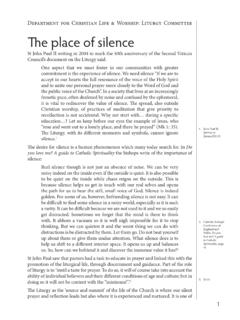

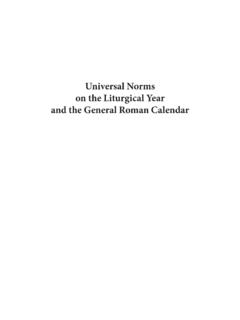



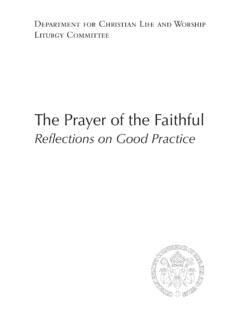
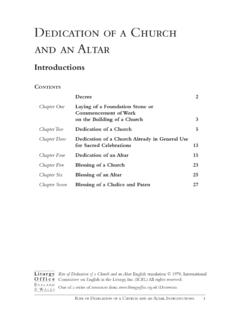
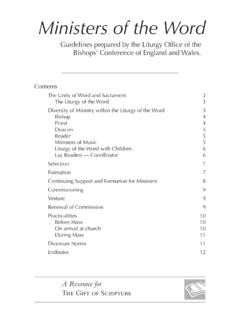
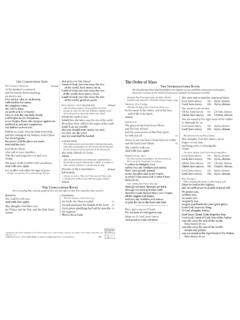
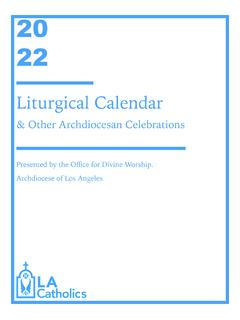
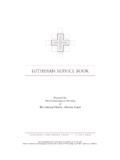


![Prayer of the Faithful 2022 [eBook]](/cache/preview/4/3/3/0/d/7/8/6/thumb-4330d786ce006811d430d4d0bdd9bef0.jpg)

